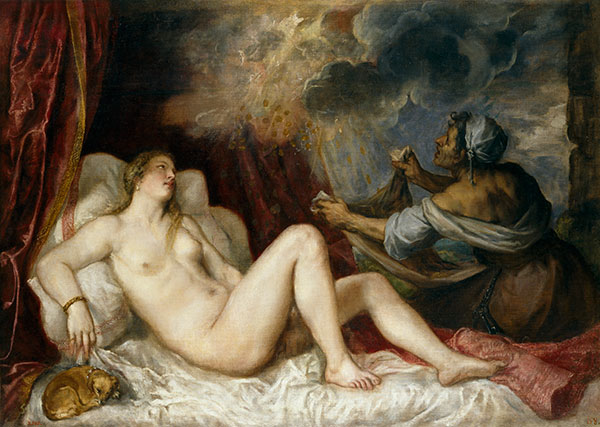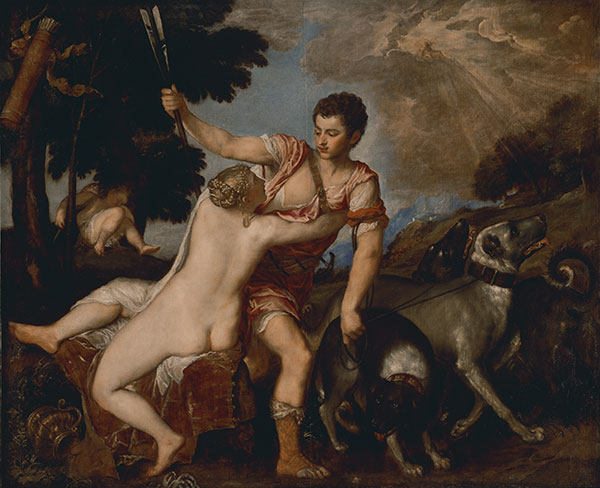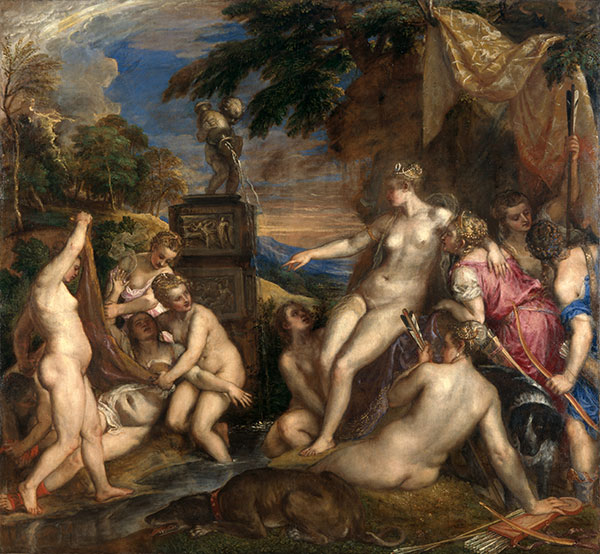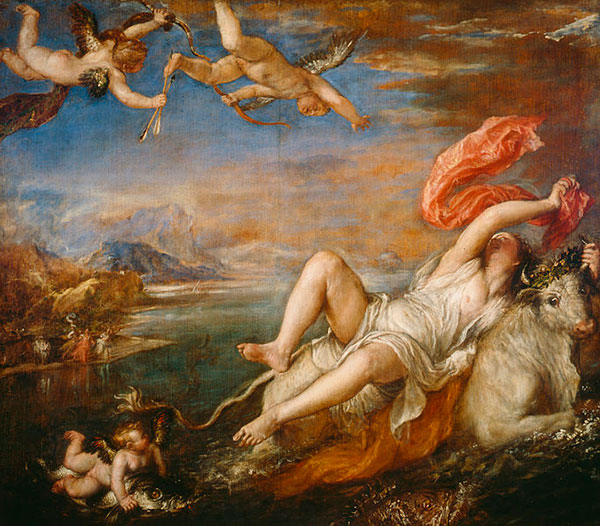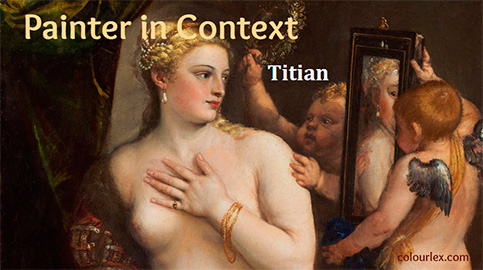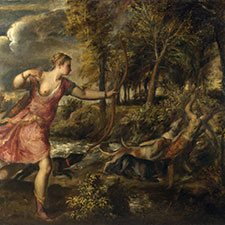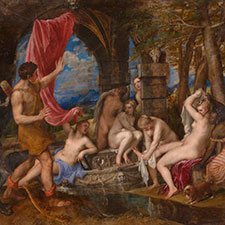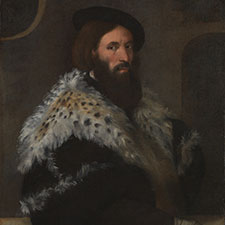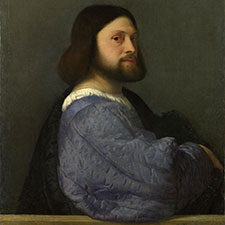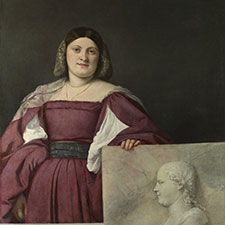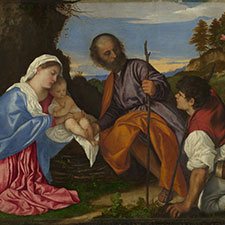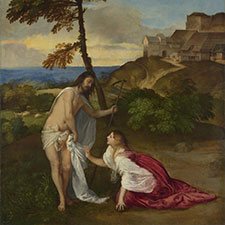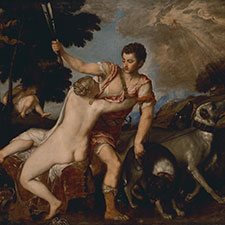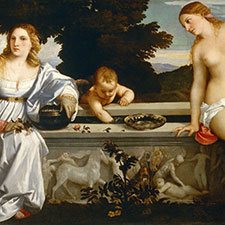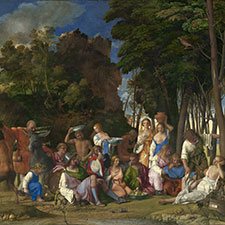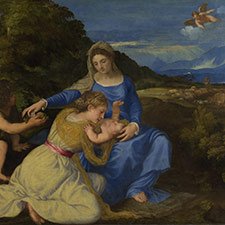Titian, Death of Actaeon
1562Paintings sorted by Historical period | Painter | Subject matter | Pigments used
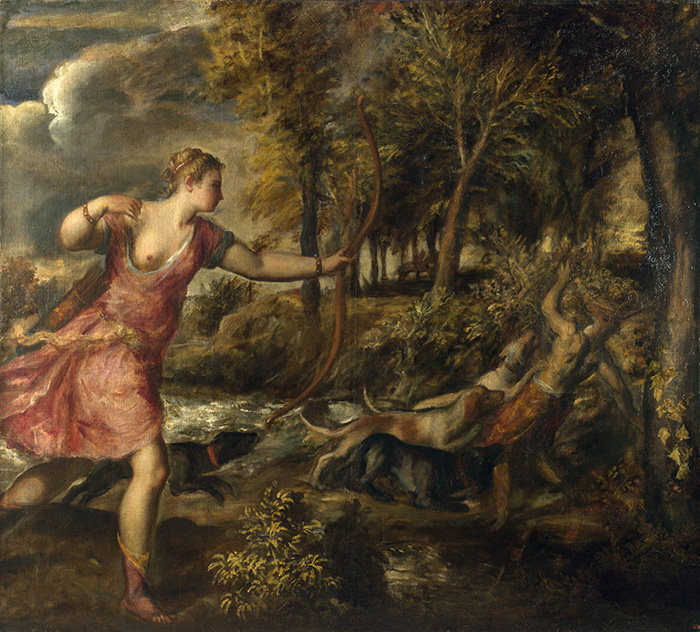
Blue sky
A layer of natural ultramarine painted over a layer of smalt.
Shadowed part of Diana’s rose-pink dress
First underlayer consisting of carmine lake (made from the insect cochineal) and lead white, the second underlayer contains red ochre and red lead in addition to the above two pigments.
The orange lining of Diana’s boots
Yellow ochre and red lead.
Diana’s deep pink boots
Carmine lake and white.
Bright green bush in the foreground
A thick layer of lead-tin yellow over several thin brown layers containing lead white, black, some umber, and a copper-containing pigment which is now of brown colour.
Tree trunk close to the bright green ivy leaf
It was first painted with several greyish-brown layers and then highlighted with a mixture of lead white, carmine lake, and ultramarine. The next layer stems from the ivy leaf and contains lead-tin yellow and lead white with a layer of now brown verdigris on top.
The green foliage of the tree in the middle of the painting
Highlights of lead-tin yellow over five layers of alternating brown and green colour. The green contains verdigris and yellow ochre.
Hover the mouse over the white points to learn about the pigments used at this spot.
Related Paintings: Titian's Poesie Paintings
Titian painted a series of paintings with mythological subjects for King Philip II of Spain. Inspired by Ovid’s Metamorphoses, they are among Titian’s most admired works (1 and 2).
Quote from the website of DeYoung Museum San Francisco
“Titian and the Poesie
Among Titian’s most breathtaking works is a series of mythological subjects known as the poesie, which celebrate the loves of
ancient gods, goddesses, and mortals. In paintings of deep, sonorous color and broken, expressive brushwork, Titian created a visual
equivalent to lyric and emotive forms of poetry. The erotic beauty of the nude female form, often encompassed in the thick atmosphere of a pastoral landscape, is the focus of these compositions. Titian’s classical literary sources, especially the Metamorphoses, completed by the Roman author Ovid around AD 8, provide a veneer of respectability for these remarkable paintings. Ultimately, however, Titian’s poesie explore a world of physical sensuality that is made palpable through his brilliant technique. Designed for the pleasure of the male viewer, paintings such as Danaë were sought after by collectors and often replicated by the artist to satisfy the requests of noble patrons.”
The Poesie paintings
Danaë with a Nurse or Danaë Receiving the Golden Rain, 1553-54, Museo del Prado, Madrid
Danaë, ca 1554, The State Hermitage Museum, St Petersburg, Russia
Danaë with Eros, 1544, Museo e Real Bosco di Capodimonte, Naples. Italy
Titian, Danaë with Nursemaid or Danaë Receiving the Golden Rain, 1560s. Museo del Prado
Venus and Adonis, 1554, The J. Paul Getty Museum
Venus and Adonis, 1554, Museo del Prado
Venus and Adonis, ca 1560, Galleria Nazionale d’Arte Antica, Rome
Venus and Adonis, ca 1560, National Gallery of Art Washington
Venus and Adonis, ca 1554, National Gallery London
Titian, Venus and Adonis, 1555-60, The J. Paul Getty Museum, Los Angeles
Diana and Actaeon, 1556-59, National Gallery London and National Galleries of Scotland
Titian, Diana and Actaeon, 1556-59, National Gallery London
Diana and Callisto, 1556-59, National Gallery London
Titian, Diana and Callisto, 1556-59, National Gallery London
Rape of Europa, 1559-62, Isabella Stewart Gardner Museum, Boston
Titian, Rape of Europa, 1559-62, Isabella Stewart Gardner Museum, Boston
Death of Actaeon, 1562, National Gallery London
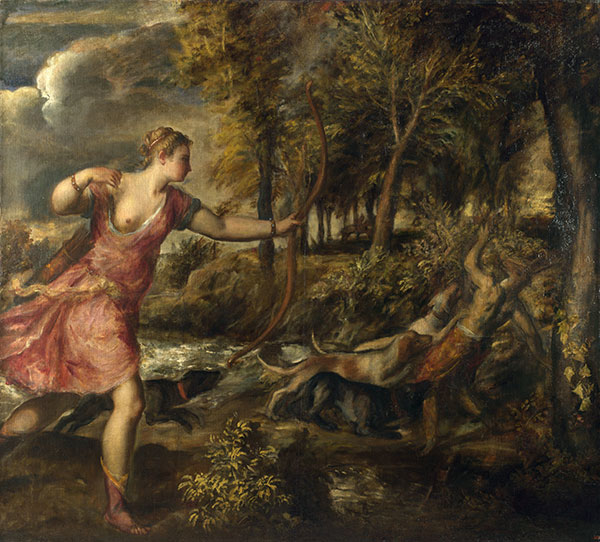
Titian, Death of Actaeon, 1562, National Gallery London
Titian, Perseus and Andromeda, 1554-56, Wallace Collection London
Titian, Tarquin and Lucretia, 1568-71, Fitzwilliam Museum, Cambridge
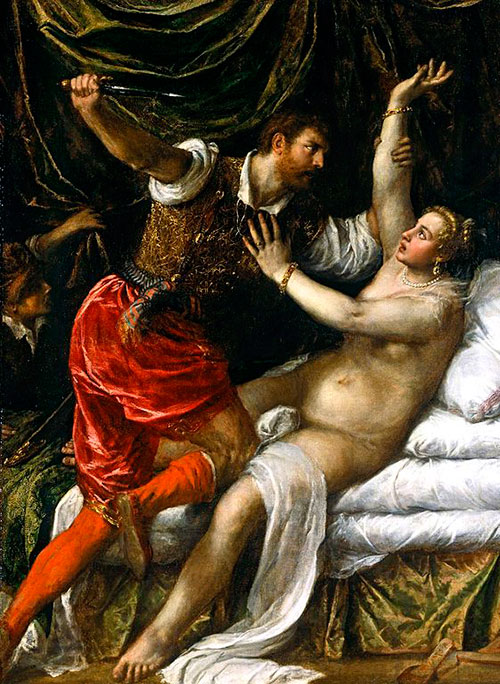
Titian, Tarquin and Lucretia, 1568-71, Fitzwilliam Museum, Cambridge
References
(1) Tanner, M, Sublime Truth and the Senses: Titian’s Poesi (Studies in Medieval and Early Renaissance Art History), Brepols N.V., 2019
(2) National Gallery London, Titian’s ‘poesie’ paintings. [Accessed 30 Jul. 2017].
The Story of Diana and Actaeon
Ovid, Metamorphoses Book III (A. S. Kline’s Version)
Bk III: 138-164 Actaeon returns from the hunt
Actaeon, one of your grandsons, was your first reason for grief, in all your happiness, Cadmus. Strange horns appeared on his forehead, and his hunting dogs sated themselves on the blood of their master. But if you look carefully, you will find that it was the fault of chance and not wickedness: what wickedness is there in error? It happened on a mountain, stained with the blood of many creatures, and midday had contracted every shadow and the sun was equidistant from either end of his journey. Then Actaeon, the young Boeotian, with a quiet expression, spoke to his companions in the hunt as they wandered through the solitary wilds ‘Friends, our spears and nets are drenched with the blood of our victims, and the day has been fortunate enough. When Aurora in her golden chariot brings another day we will resume our purpose. Now Phoebus is also between the limits of his task, and is splitting open the earth with his heat. Finish your present task and carry home the netted meshes’ The men obeyed his order and left off their labour.
There was a valley there called Gargaphie, dense with pine trees and sharp cypresses, sacred to Diana of the high-girded tunic, where, in the depths, there is a wooded cave, not fashioned by art. But ingenious nature had imitated art. She had made a natural arch out of native pumice and porous tufa. On the right, a spring of bright clear water murmured into a widening pool, enclosed by grassy banks. Here the woodland goddess, weary from the chase, would bathe her virgin limbs in the crystal liquid.
a
Bk III: 165-205 Actaeon sees Diana naked and is turned into a stag.
Having reached the place, she gives her spear, quiver and unstrung bow to one of the nymphs, her weapon-bearer. Another takes her robe over her arm, while two unfasten the sandals on her feet. Then, more skilful than the rest, Theban Crocale gathers the hair strewn around her neck into a knot, while her own is still loose. Nephele, Hyale, Rhanis, Psecas and Phiale draw water, and pour it over their mistress out of the deep jars.
While Titania is bathing there, in her accustomed place, Cadmus’s grandson, free of his share of the labour, strays with aimless steps through the strange wood, and enters the sacred grove. So the fates would have it. As soon as he reaches the cave mouth dampened by the fountain, the naked nymphs, seeing a man’s face, beat at their breasts and filling the whole wood with their sudden outcry, crowd round Diana to hide her with their bodies. But the goddess stood head and shoulders above all the others. Diana’s face, seen there, while she herself was naked, was the colour of clouds stained by the opposing shafts of sun, or Aurora’s brightness.
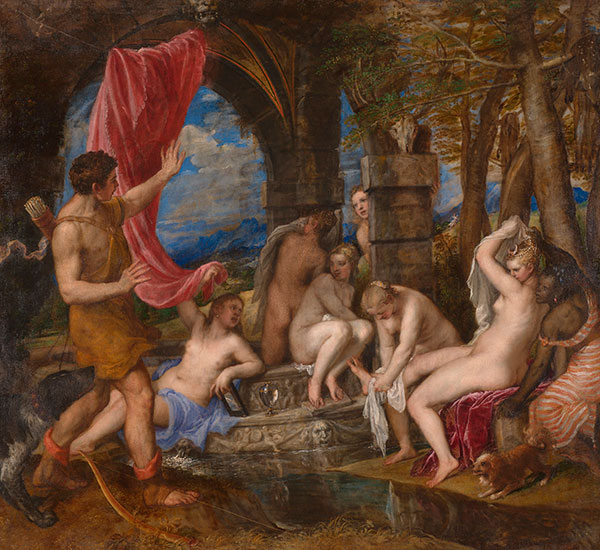
However, though her band of nymphs gathered in confusion around her, she stood turning to one side, and looking back, and wishing she had her arrows to hand. She caught up a handful of the water that she did have, and threw it in the man’s face. And as she sprinkled his hair with the vengeful drops she added these words, harbingers of his coming ruin, ‘Now you may tell, if you can tell that is, of having seen me naked!’ Without more threats, she gave the horns of a mature stag to the head she had sprinkled, lengthening his neck, making his ear-tips pointed, changing feet for hands, long legs for arms, and covering his body with a dappled hide. And then she added fear. Autonoë’s brave son flies off, marveling at such swift speed, within himself. But when he sees his head and horns reflected for certain in the water, he tries to say ‘Oh, look at me! but no voice follows. He groans: that is his voice, and tears run down his altered face. Only his mind remains unchanged. What can he do? Shall he return to his home and the royal palace, or lie hidden in the woods? Shame prevents the one, and fear the other.
Bk III: 206-231 Actaeon is pursued by his hounds
While he hesitates his dogs catch sight of him. First ‘Black-foot’, Melampus, and keen-scented Ichnobates, ‘Tracker’, signal him with baying, Ichnobates out of Crete, Melampus, Sparta. Then others rush at him swift as the wind, ‘Greedy’, Pamphagus, Dorceus, ‘Gazelle’, Oribasos, ‘Mountaineer’, all out of Arcady: powerful ‘Deerslayer’, Nebrophonos, savage Theron, ‘Whirlwind’, and Laelape, ‘Hunter’.
Then swift-footed Pterelas, ‘Wings’, and trail-scenting Agre, ‘Chaser’, fierce Hylaeus, ‘Woody’, lately gored by a boar, the wolf-born Nape, ‘Valley’, Poemenis, the trusty ‘Shepherd’, and Harpyia, ‘Snatcher’, with her two pups. There is thin-flanked Sicyonian Ladon, ‘Catcher’, Dromas, ‘Runner’, ‘Grinder’, Canache, Sticte ‘Spot’, Tigris ‘Tigress’, Alce, ‘Strong’, and white-haired Leucon, ‘Whitey’, and black-haired Asbolus, ‘Soot’.
Lacon, ‘Spartan’, follows them, a dog well known for his strength, and strong-running Aëllo, ‘Storm’. Then Thoos, ‘Swift’, and speedy Lycisce, ‘Wolf’, with her brother Cyprius ‘Cyprian’. Next ‘Grasper’, Harpalos, with a distinguishing mark of white, in the centre of his black forehead, ‘Black’, Melaneus, and Lachne, ‘Shaggy’, with hairy pelt, Labros, ‘Fury’, and Argiodus, ‘White-tooth’, born of a Cretan sire and Spartan dam, keen-voiced Hylactor, ‘Barker’, and others there is no need to name. The pack of them, greedy for the prey follow over cliffs and crags, and inaccessible rocks, where the way is hard or there is no way at all. He runs, over the places where he has often chased, flying, alas, from his own hounds. He longs to shout ‘I am Actaeon! Know your own master!’ but words fail him, the air echoes to the baying.
Bk III: 232-252 Actaeon is killed by the dogs
First ‘Black-hair’, Melanchaetes, wounds his back, then ‘Killer’, Theridamas, and Oresitrophos, the ‘Climber’, clings to his shoulder. They had set out late but outflanked the route by a shortcut over the mountains. While they hold their master the whole pack gathers and they sink their teeth in his body till there is no place left to wound him. He groans and makes a noise, not human, but still not one a deer could make, and fills familiar heights with mournful cries. And on his knees, like a suppliant begging, he turns his wordless head from side to side, as if he were stretching arms out towards them.
Now his friends, unknowingly, urge the ravening crowd of dogs on with their usual cries, looking out for Actaeon, and shouting, in emulation, for absent Actaeon (he turning his head at the sound of his name) complaining he is not there, and through his slowness is missing the spectacle offered by their prey. He might wish to be absent it’s true, but he is here: he might wish to see and not feel the fierce doings of his own hounds. They surround him on every side, sinking their jaws into his flesh, tearing their master to pieces in the deceptive shape of the deer. They say Diana the Quiver-bearer’s anger was not appeased, until his life had ended in innumerable wounds.
 Titian, Death of Actaeon, 1559-75
Titian, Death of Actaeon, 1559-75
Overview
Medium: Oil
Support: Canvas
Size: 178.8 x 197.8 cm
Art period: High Renaissance
National Gallery London
Inventory number: NG6420
Titian’s depiction of the dramatic story of Actaeon who surprised the goddess Diana at her bath in the forest. Diana was furious at this intrusion into her privacy and transformed him into a stag which was then killed by his own dogs. This is one of the series of ‘poesie’ paintings with mythological subjects painted for King Philip II of Spain. Inspired by Ovid’s Metamorphoses, they are among Titian’s most admired works.
Titian employed an extensively wide palette of nearly all pigments known in the Renaissance such as carmine cochineal, vermilion, red lead, natural ultramarine, smalt, verdigris, ochres, and lead-tin yellow, possibly even orpiment, and realgar.
Diana and Actaeon, Diana and Callisto, and The Death of Actaeon were hung together as part of the spectacular multi-arts project Metamorphosis: Titian 2012 staged jointly by the National Gallery London and the Royal Opera House.
Pigments
Pigment Analysis
The following pigment analysis is based on the work of scientists at the National Gallery London (1). Titian made several significant changes to the composition as has been shown by x-ray radiography and infrared reflectography and confirmed by the pigment analysis.
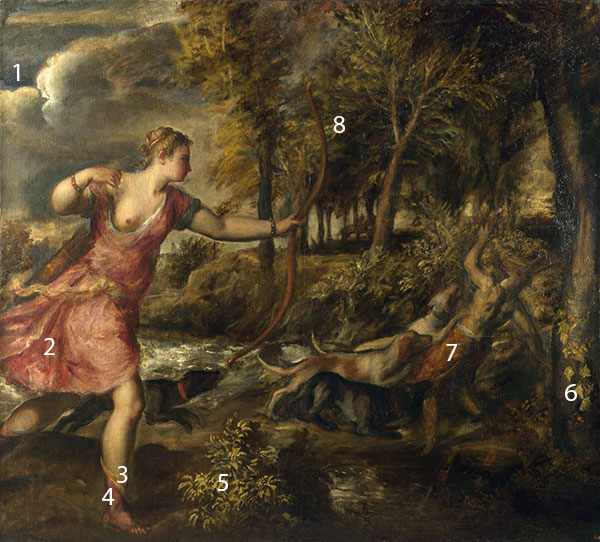
1 Blue sky: a layer of natural ultramarine painted over a layer of smalt.
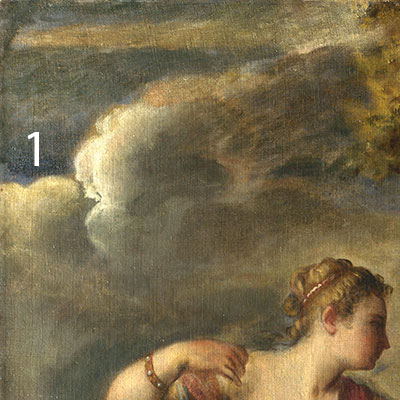
2 Shadowed part of Diana’s rose-pink dress: The first underlayer consists of carmine cochineal lake and lead white, the second underlayer contains red ochre and red lead in addition to the above two pigments.
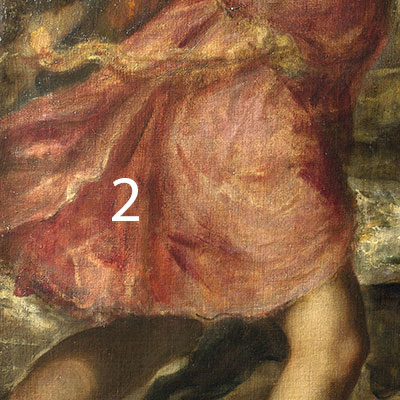
3 Orange lining of Diana’s boots: yellow ochre and red lead.
4 Diana’s deep pink boots: carmine lake and white.
5 Bright green bush in the foreground: a thick layer of lead-tin yellow over several thin brown layers containing lead white, black, some umber, and a copper-containing pigment which is now of brown colour.
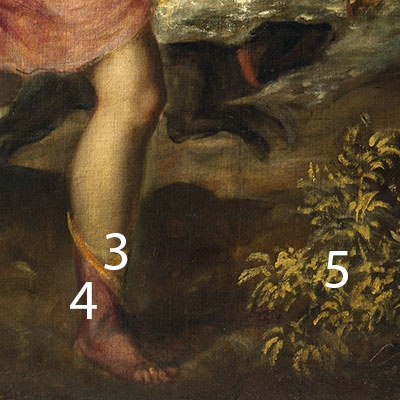
6 Tree trunk close to the bright green ivy leaf: it was first painted with several greyish-brown layers and then highlighted with a mixture of lead white, carmine lake, and ultramarine. The next layer stems from the ivy leaf and contains lead-tin yellow and lead white with a layer of now brown verdigris on top.
7 Actaeon’s orange tunic: probably red and yellow ochre perhaps with some orpiment and realgar.
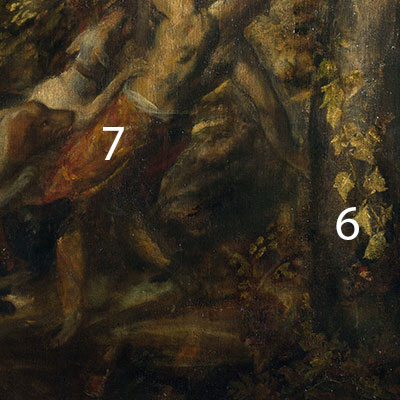
8 Green foliage of the tree in the middle of the painting: Highlights of lead-tin yellow over five layers of alternating brown and green colour. The green contains verdigris and yellow ochre.

References
(1) Jill Dunkerton and Marika Spring. With contributions from Rachel Billinge, Helen Howard, Gabriella Macaro, Rachel Morrison, David Peggie, Ashok Roy, Lesley Stevenson and Nelly von Aderkas, Titian after 1540: Technique and Style in his Later Works, National Gallery Technical Bulletin 36, 2017, pp. 6-39. Catalog: Part 2 pp. 104-116. Jacqueline Ridge and Marika Spring, The Conservation History of Titian’s ‘Diana and Actaeon’ and ‘Diana and Callisto’ pp. 116-123. Notes and Bibliography pp. 124-136.
Pigments Used in This Painting
Resources
See the collection of online and offline resources such as books, articles, videos, and websites on Titian in the section ‘Resources on Painters‘
PowerPoint Presentations
Painter in Context: Titian
A richly illustrated presentation on the Venetian Renaissance painter Titian (Tiziano Vecellio) containing information on painting technique, pigments employed, and important written and online resources.
Number of slides: 23
Formats included in the download: PowerPoint Screen Presentation (ppsx) and pdf
Videos
Video: Titian, Death of Actaeon' by National Gallery London
Video: 'Titian, Death of Actaeon' by George Shaw, National Gallery London
Video: 'Titian: Love, Desire, Death, by National Gallery London
Publications and Websites
Publications
(1) Jill Dunkerton and Marika Spring. With contributions from Rachel Billinge, Helen Howard, Gabriella Macaro, Rachel Morrison, David Peggie, Ashok Roy, Lesley Stevenson and Nelly von Aderkas, Titian after 1540: Technique and Style in his Later Works, National Gallery Technical Bulletin 36, 2017, pp. 6-39. Catalog: Part 1 pp 40-75, and Part 2 pp. 104-116. Notes and Bibliography pp. 124-136.
(2) Lawson, James. “Titian’s Diana Pictures: The Passing of an Epoch” Artibus Et Historiae, vol. 25, no. 49, 2004, pp. 49–63.
(3) Irina Jauhiainen, Titian’s Diana and Actaeon and Death of Actaeon as Illustrations of a Sacrifice which Differentiates Human Spirit from Animal Materiality, Philosophy of Art History K1531551.
(4) White, C., Metamorphosis: Titian 2012, Studio International – Visual Arts, Design and Architecture, 14. January 2013. [Accessed 30 Jul. 2017].
(5) Cocke, R. (1999), Titian the second Apelles: the Death of Actaeon. Renaissance Studies, 13: 303–311. doi:10.1111/j.1477-4658.1999.tb00079.x
(6) Tanner M, Sublime truth and the senses: Titian’s poesie for King Philip II of Spain (Studies in Medieval and Early Renaissance Art History), Harvey Miller Publishers, London 2017.
Websites
Titian’s ‘poesie’: The commission, National Gallery London

